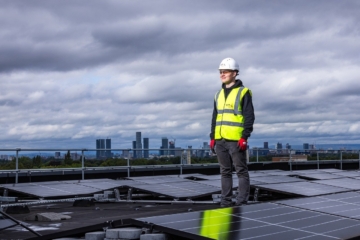Energy Efficiency Meets Innovation: The Promise of Net-Zero Energy Buildings

In the quest for a sustainable future, Net-Zero Energy Buildings (NZEB) stand out as a beacon of innovation and environmental responsibility. As climate change accelerates and the demand for energy continues to grow, the construction industry faces immense pressure to adopt greener practices. NZEBs offer a compelling solution by balancing energy consumption with energy production, thereby reducing the overall carbon footprint. In this blog, we'll explore what NZEBs are, their benefits, and how they are shaping the future of construction.
What Are Net-Zero Energy Buildings?
Net-Zero Energy Buildings are designed to produce as much energy as they consume over the course of a year. This is achieved through a combination of energy efficiency measures and on-site renewable energy generation. The ultimate goal is to achieve a balance where the total amount of energy used by the building annually is equal to the amount of renewable energy created on-site or by renewable energy sources elsewhere.
Net-Zero Energy Buildings (NZEBs) are designed to minimize energy loss through the incorporation of advanced building materials and design techniques. They feature high-performance insulation, energy-efficient windows, and airtight construction, all of which significantly reduce the need for heating and cooling.
In addition to these efficiency measures, NZEBs often utilize renewable energy systems, such as solar panels, wind turbines, or geothermal systems, to generate electricity and heat. By harnessing renewable energy, these buildings can greatly reduce their reliance on fossil fuels. Furthermore, the integration of smart building technologies, such as automated lighting, HVAC systems, and energy management systems, helps optimize energy use and maintain a balance between energy consumption and production. Finally, NZEBs emphasize the use of sustainable and locally sourced materials, which lowers the environmental impact associated with the extraction, processing, and transportation of building materials.
What are the benefits?
Environmental Impact
One of the most significant benefits of NZEBs is their positive environmental impact. These buildings play a crucial role in reducing greenhouse gas emissions, thus aiding the fight against climate change. By generating their own energy, NZEBs minimize dependence on non-renewable energy sources and contribute to a lower overall carbon footprint.
Economic Savings
While the initial investment in NZEBs can be higher than traditional buildings, they provide substantial economic savings in the long run. The reduced energy costs over time can offset the upfront expenses, making these buildings a financially viable option. Homeowners and businesses alike can benefit from lower energy bills, ultimately leading to significant cost savings.
Energy Independence
NZEBs also promote energy independence by generating their own power. This self-sufficiency reduces vulnerability to energy price fluctuations and enhances energy security, providing a more stable and predictable energy supply for occupants.
Enhanced Comfort and Health
The advanced design and technologies utilized in NZEBs contribute to enhanced comfort and health for occupants. These buildings typically offer better indoor air quality and maintain consistent indoor temperatures, leading to an overall improved living and working environment.
Latest insights & stories

MOBILIDATA
In Flanders, we strive to work on tomorrow’s mobility today. That includes the Mobilidata programme. With this programme, various levels of government, companies and researchers are jointly developing innovative, technological traffic solutions for road users, such as better route advice, tailored traffic notifications and intelligent traffic lights. New connected mobility and know-how do not stop at our national borders however, so international collaboration is needed to exchange knowledge and set up joint projects to implement it.

Digital sovereignty guarantees data security in the public cloud
When companies consider migrating to the public cloud, they are sometimes held back by security risks and compliance and governance constraints. Thus the interest in digital sovereignty, Gwénaëlle Hervé, Public & Sovereign Cloud Lead at Proximus NXT, explains.

ROAD SAFETY
Since 2018, the number of traffic casualties in Flanders has risen again. Currently, the figures are stagnating, but the risk of accidents with injuries remains high for vulnerable road users in Flanders. And that while traffic should be safe for all users and modes. We want to change this by focusing on transparent policy, training on safe behavior, infrastructure improvements, legislation and enforcement.